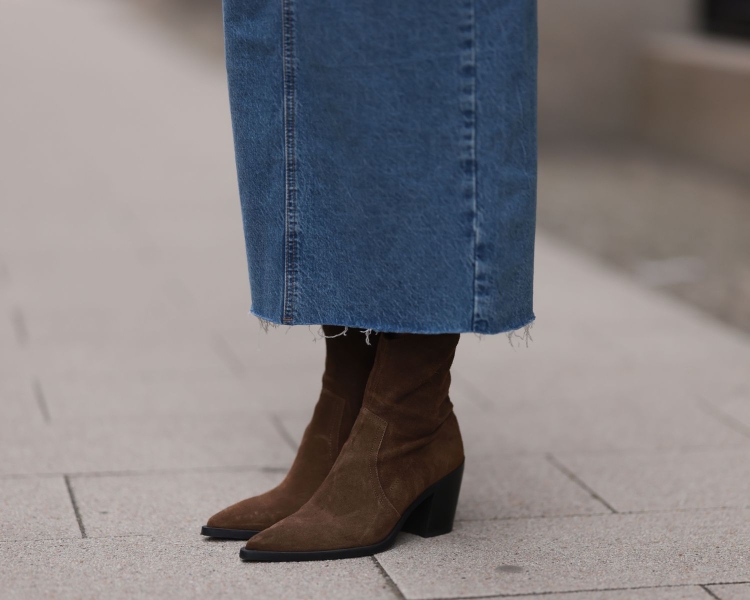In This Article View All In This Article
- Water Marks
- Dirt and Mud
- Scuffs and Salt
- Food and Oil Stains
- Additional Tips

A timeless and classic accessory to any outfit, suede boots are hard to beat when it comes to chic all-year-round styles. From dressing up your casual denim with a stylish ankle boot to adding a bit of flair with a knee-high to your favorite sweater dress, suede is one of those fabrics that make every outfit look effortless. One problem? Suede can easily get damaged, especially when you’re dealing with water. A few drops of water or other scuffs and stains can be remedied with a bit of product and elbow grease—but if you get your boots soaking wet, you’re in for trouble.
“You should also avoid wearing suede boots in wet, muddy, or even snowy weather conditions,” says expert Shaniece Jones. But if you do have to brace a few storms, “there are a few home products that you can use to clean your suede boots like a toothbrush, baking soda, and white vinegar.”
Removing stains from suede is definitely challenging, but there is hope. In case your treasured pair of boots needs a bit of TLC, we’ve listed a few of the most common stains for suede and how to get rid of them in a flash, according to fashion and cleaning experts.
Water Marks
Suede is very soft, and its smooth texture gives it an extra appeal. This is great for styling with harsher fabrics (leather, for example) but not quite ideal when dealing with water—aka, never wear your suede out in the rain. If you do find yourself with a pair of damp suede boots, one method to restore them to their fresh-out-of-the-box glory is to use water. Counterintuitive, we know, but the most effective way to clean water stains from suede is to gently coat your shoes with water using a spray bottle. Then, lightly brush the stain and soak up any excess water with a cloth or paper towel before letting it air dry.
Before venturing out into the elements with your new suede boots, you can actually waterproof them using a suede waterproofing spray. If you’re treating an old pair, be sure only to apply this when your shoes are completely dry.
Dirt and Mud
Dirt and mud stains are unavoidable and can be especially tricky to remove. First things first, if you stain your suede boots, make sure the fabric completely dries before attempting to clean them. When drying, try to avoid direct sunlight to prevent further damage. Once dry, the first step is to brush away the excess dirt with gentle pressure. For this, you can use a suede brush or a clean toothbrush, whatever you have handy. If stubborn stains remain, try using a steamer to loosen the fibers and uplift the dirt from deep within the fabric. Lightly blot a paper towel or cloth to help lift it out on super tough stains. Let your boots dry before attempting again, if needed, says Jones.

Scuffs and Salt
Though the most common, scuff marks may be the easiest to remove (thank you, fashion gods!). Believe it or not, a Magic Eraser can do the trick on most occasions. Be sure to spot test on a small area before diving into the full cleaning. Once you prove the Magic Eraser won’t cause further damage, put in a bit of elbow grease and get to scrubbing. For salt stains brought on by snowy or even beachy weather (summer concerts call for boots!), start by brushing away any excess salt. Once complete, mix cold water with a small amount of dish soap and dip a clean cloth in your mixture. Gently blot the stain and repeat as needed until your shoes are back to their former glory.
Food and Oil Stains
You may be under the impression that oil and grease stains are the death of all your clothing, but fret not; there are a few techniques to salvage your beloved suede shoes. Try sprinkling the stain with baby powder, cornstarch, or baking soda to absorb the oil. Let this sit for at least an hour before brushing away with a soft brush. The powder may appear oily after sitting on the stain, but this means it’s doing the job! Another method is to utilize a common household ingredient: dish soap. Using a mixture of soap and water, gently dab onto your shoe and let it sit for 10 to 15 minutes before rinsing away with a slightly damp cloth. Make sure your clothes are not too wet when applying.
Additional Tips
For tough stains, you can rub out the troubled area with rubber. When applying, be sure to add pressure without rubbing too hard, or else you run the risk of damaging the fabric. Jones also recommends vinegar, which can be helpful when cleaning suede. Dip a cloth or paper towel in white vinegar before gently rubbing the stain, taking extra precautions to dampen but not soak the fabric. Don’t be alarmed if the color of your shoes gets a bit darker; this is a normal part of the process, and they will return to their typical hue when fully dry. Allow your shoes to dry, and repeat the process as needed.

